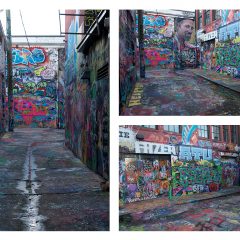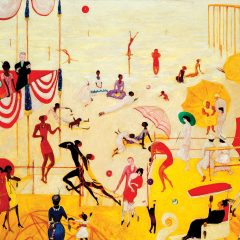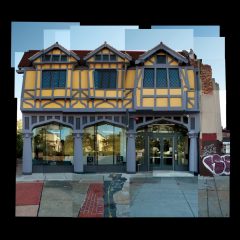Book Review by Andrea Kirsh

Cover of More Philadelphia Murals and the Stories They Tell
The Philadelphia Mural Arts Program (MAP) has come out with a second, fully-illustrated book: More Philadelphia Murals and the Stories They Tell ( by Jane Golden et al, published by Temple University Press; available here ).
The program is justly proud of its more than two decades of work which has covered more than 2600 walls in Philadelphia. Its success reflects a clarity of purpose highly unusual among public art programs. It began under the auspices of an anti-graffiti program when Jane Golden, the artist charged with the task, realized that the most successful strategy was to offer disaffected youth a more challenging but equally-public outlet for expression, in the form of neighborhood murals. The MAP has continued and enormously expanded its youth education program for students from grade school through high school.
Beyond the class-bound artworld

Jack Ramsdale’s portrait of Paul Robeson
The program’s second goal is the use of art for community beautification as an outgrowth of community engagement. Community groups request the murals, filing competitive applications, and they have a say over every aspect of the art. This latter feature is the program’s key. MAP, as a government program, officially commissions the murals. But MPA has designed a process whereby the immediate neighborhood becomes the art patron. And the neighborhoods have largely been working-class.
Philadelphia’s murals have received almost no attention from the fine arts world, and I suspect this is the reason. For all the rhetoric of contemporary art ignoring boundaries between high and low, it is still an intensely class-bound community.

“History of the Trolley,” by Karl Yoder
The aesthetic of MAP is largely one of illustration (whether of children’s books, magazines or greeting cards), rather than of the gallery, museum or even the alternative space. The mural I like best in my neighborhood is Karl Yoder’s grisaille “History of the Trolley,” at 45th and Baltimore, that depicts bowler-hatted men who were the trolley’s first commuters. I suspect I like it because those men seem to have wandered out of a Paul Delvaux painting, leaving Delvaux’s nudes behind; but that’s my own rather unusual take on it. Any public program that has communities competing for the visual arts (whether images of landscapes or portraits of local heroes) has my support and admiration.
Volume 2–how it’s different
MAP’s first book, Philadelphia Murals and the Stories They Tell (2002), in keeping with its emphasis on community-building, downplayed the role and identity of individual artists and left me unclear as to how they were even selected. The second book makes more of the artists, profiling one in each chapter, and attempts to situate the program within art and mural production in the twentieth century The text is considerably more successful in documenting the program’s expanding social ambitions, which include working with prison populations and victims’ groups.

Tuscan Landscape, a mural by Tish Ingersoll
In fact most of the text consists of anecdotal histories of the various murals and their participants. Most readers will buy these books for their pictures and the stories behind them, and they won’t be disappointed. You may not find all your favorite murals here (you can always search for them at the murals database), but you’re sure to recognize many of them and will be inspired to search out others.
–Andrea Kirsh is an art historian living in Philadelphia. See her Philadelphia Introductions essays on emerging artists at inliquid.










